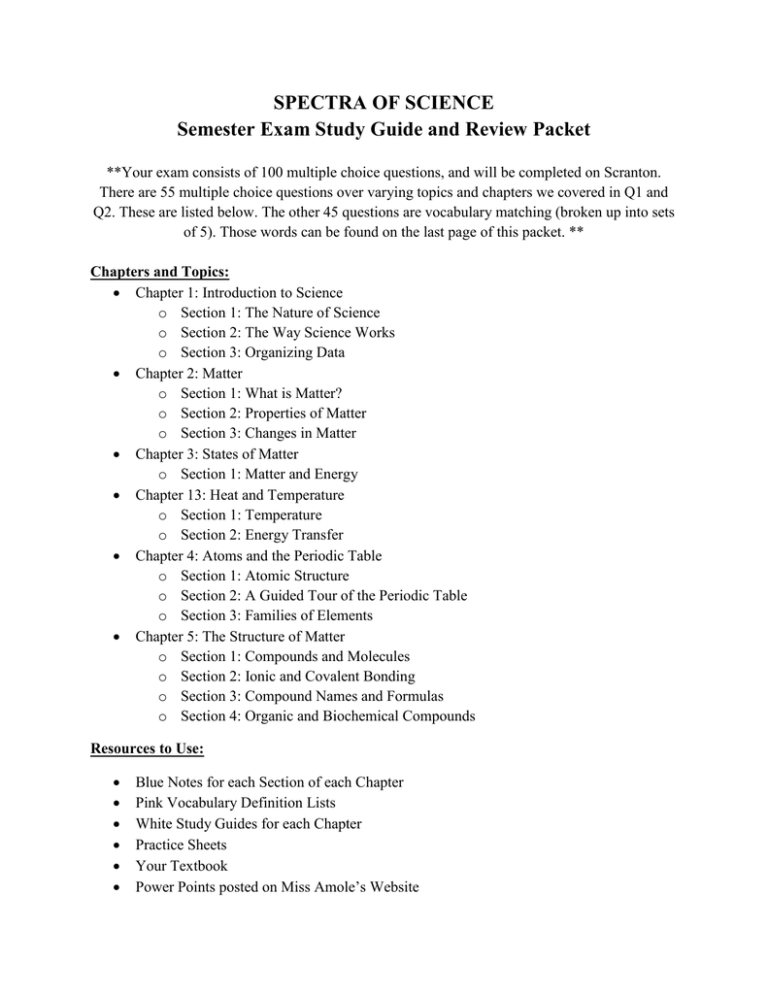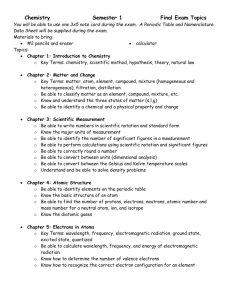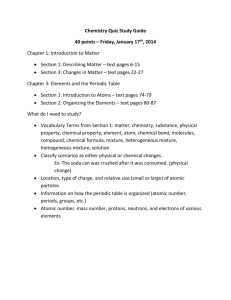SPECTRA OF SCIENCE Semester Exam Study Guide and Review
advertisement

SPECTRA OF SCIENCE Semester Exam Study Guide and Review Packet **Your exam consists of 100 multiple choice questions, and will be completed on Scranton. There are 55 multiple choice questions over varying topics and chapters we covered in Q1 and Q2. These are listed below. The other 45 questions are vocabulary matching (broken up into sets of 5). Those words can be found on the last page of this packet. ** Chapters and Topics: Chapter 1: Introduction to Science o Section 1: The Nature of Science o Section 2: The Way Science Works o Section 3: Organizing Data Chapter 2: Matter o Section 1: What is Matter? o Section 2: Properties of Matter o Section 3: Changes in Matter Chapter 3: States of Matter o Section 1: Matter and Energy Chapter 13: Heat and Temperature o Section 1: Temperature o Section 2: Energy Transfer Chapter 4: Atoms and the Periodic Table o Section 1: Atomic Structure o Section 2: A Guided Tour of the Periodic Table o Section 3: Families of Elements Chapter 5: The Structure of Matter o Section 1: Compounds and Molecules o Section 2: Ionic and Covalent Bonding o Section 3: Compound Names and Formulas o Section 4: Organic and Biochemical Compounds Resources to Use: Blue Notes for each Section of each Chapter Pink Vocabulary Definition Lists White Study Guides for each Chapter Practice Sheets Your Textbook Power Points posted on Miss Amole’s Website SPECTRA OF SCIENCE Learning Targets and Self-Evaluation Directions: Use the list of Learning Targets below to rate yourself and to determine which areas you will need to spend most time studying and reviewing. Ch.# 1.1 1.2 1.3 Learning Targets: I am able to analyze and experiment and determine if it is a controlled experiment by identifying the independent, dependant, and controlled variables. I can identify the steps in the scientific method in order, and explain each step. I can differentiate between an observation and inference. 1.8 1.9 I can make detailed observations and use these to make logical inferences. I can apply the scientific method to solve problems and conduct investigations. I am able to identify the 3 main branches of natural science and give examples of areas of science that fall under these branches. I am able to identify why scientists use the International System (SI) of Units. I know the meaning of the prefixes used in SI units. I can identify the SI base units used to measure different quantities. 1.10 I am able to read and write numbers in scientific notation. 1.4 1.5 1.6 1.7 1.11 1.12 1.13 1.14 1.15 1.16 1.17 1.18 1.19 1.20 I am able to convert values from standard form into scientific notation and vise-versa. I am able to use a dimensional analysis grid to convert numbers in the SI system of units. I know the rules that determine significant and non-significant digits. I can make calculations with solutions that contain the appropriate amount of significant figures. I am able to identify which type graph is best to use for the data displayed. I can interpret, create, and read bar, line, and circle graphs. I can differentiate between a scientific law and a scientific theory. I can explain the difference between precision and accuracy and determine if a set of data demonstrates these qualities. I am able to define technology and evaluate its affects on society, both advantages and disadvantages. I am able to define and use scientific models to enhance my understanding of scientific concepts. I Know Well I Need Review 2.1 2.2 2.3 2.4 2.5 2.6 2.7 2.8 2.9 2.10 2.11 2.12 2.13 3.1 3.2 3.3 3.4 3.5 3.6 3.7 3.8 13.9 13.10 13.11 13.12 I am able to define matter and its properties. I am able to explain the difference between a physical and a chemical property of matter. I am able to use the density formula to calculate for mass, volume, or density using the appropriate units. I am able to compare densities to determine the buoyancy of substances. I am able to read chemical formulas and determine the number of atoms and elements in a molecule. I can explain the difference between an atom and a molecule. I am able to explain the difference between an element, compound, pure substance, and a mixture. I am able to give examples of elements, compounds, and mixtures. I am able to determine if a mixture is homogeneous or heterogeneous and give examples of each type. I am able to design a process and use it to separate a mixture into its separate components. I am able to determine if a change in matter is physical or chemical. I am able to explain the difference between physical and chemical changes. I can give examples of physical and chemical changes. I am able to describe the four states of matter in terms of volume, shape, and particle behavior. I am able to identify, define, and explain how particles behave during phase change processes (i.e. condensation, evaporation, sublimation, etc.). I am able to distinguish between an endothermic and exothermic change. I am able to describe and use kinetic theory to describe how heated particles behave. I know the law of conservation of mass. I know the law of conservation of energy. I am able to name and describe different forms of energy. I able to trace energy transformations in a system. I know the boiling and freezing points of water in the Fahrenheit, Celsius, and Kelvin temperature scales. I am able to convert from one temperature scale to another. I am able to name and describe the three types of heat transfer methods. I am able to describe how convection current works. 4.1 4.2 4.3 4.4 4.5 4.6 4.7 4.8 5.1 5.2 5.3 5.4 5.5 5.6 5.7 5.8 5.9 5.10 I can define and differentiate between atoms, isotopes, cations, and anions, and discuss how each is formed. I can identify the 3 subatomic particles, and describe them in terms of location and charge. I am able to construct accurate Bohr models and Lewis Dot diagrams of atoms. I can determine an ion’s charge by evaluating the number of protons and electrons it contains. I can use the periodic table to identify the number of protons, neutrons, and electrons in an atom. I can use the periodic table to identify key information about elements including atomic number, atomic mass, elemental symbol, and most commonly occurring ions. I am able to discuss relative milestones and the scientists who contributed in the development of atomic theory. I can explain the organization of the periodic table and identify similar properties of elements given their location in the table. I can describe and illustrate the difference between an element, compound, and mixture. I am able to explain the reasons why elements and molecules form bonds. I can define and discuss properties associated with ionic, covalent, and metallic bonds. I am able to determine the type of bond that exists between elements given its chemical formula or chemical name. I am able to create Lewis dot diagrams and use these to predict the types and how elements might bond together. I am able to read, write, and name ionic compounds. I am able to read, write, and name covalent compounds. I can explain the meaning and purpose of Roman numerals that occur in the names of chemical compounds. Given the chemical formula, I am able to identify the charge of transition metals in a compound. I can identify what makes a compound organic, and discuss the important functions some of these compounds perform. What I need to study most: SPECTRA OF SCIENCE Semester Exam Study Guide Know the order of steps in the scientific method and what occurs in each step Be able to describe a controlled experiment Know the three main branches of science Know the meanings of the prefixes found in the International System of Units (SI) Be able to convert within the SI system Be able to write numbers in scientific notation from standard form and vise versa Know which type is best for which type of data Know the difference between a scientific law and theory Know the difference between precision and accuracy Be able to define and calculate density Be able to determine if a substance will sink or float in a liquid Know the density of water Know how to read chemical formulas and be able to identify the number of atoms and elements in a molecule Be able to identify if a substance is either an element, compound, or mixture Be able to identify a substance as a homogeneous or heterogeneous mixture Be able to define and identify examples of physical and chemical changes Be able to define and identify examples of observations and inferences Be able to describe the four states of matter in terms of volume and shape Know the difference between an endothermic and exothermic change Know the relationships between heat transfer, temperature, and kinetic energy Know the Law of Conservation of Mass and the Law of Conservation of Energy Know about the three temperature scales: Kelvin, Celsius, Fahrenheit Be able to identify good insulators and conductors Know the three heat transfer methods and examples of each: Conduction, Convection, Radiation Be able to identify the three subatomic particles, their charge, and their location Know how electrons are believed to behave in the most modern models of the atom Be able to determine an ion’s electric charge given its element name and number of electrons only Be able to find the number of protons, neutrons, and electrons of an atom given only its name, symbol, or atomic number and atomic mass Be familiar with the different families and groups of elements in the periodic tables and the similarities in their properties Be able to identify what ions elements in Groups 1, 2, 17, and 18 are more likely to create and how they are created Know the basic organization and information found in the periodic table Know the difference between covalent and ionic bonding and how they are formed Be able to name and write ionic and covalent compounds Know the definitions to the following Vocabulary Words: o Absolute zero o Accuracy o Atom o Atomic Mass o Atomic Number o Chemical Bond o Chemical Change o Compound o Conduction o Conductor o Convection o Covalent Bond o Density o Dependent Variable o Electrons o Element o Empirical Formula o Endothermic o Exothermic o Heat o Heterogeneous o Homogeneous o Independent Variable o o o o o o o o o o o o o o o o o o o o o o Inference Insulator Ion Ionic Bond Isotope Precision Matter Mixture Molecule Neutrons Scientific Method Observation Physical Change Protons Pure Substance Radiation Scientific Law Science Scientific Notation Scientific Theory Temperature Valence Electron





